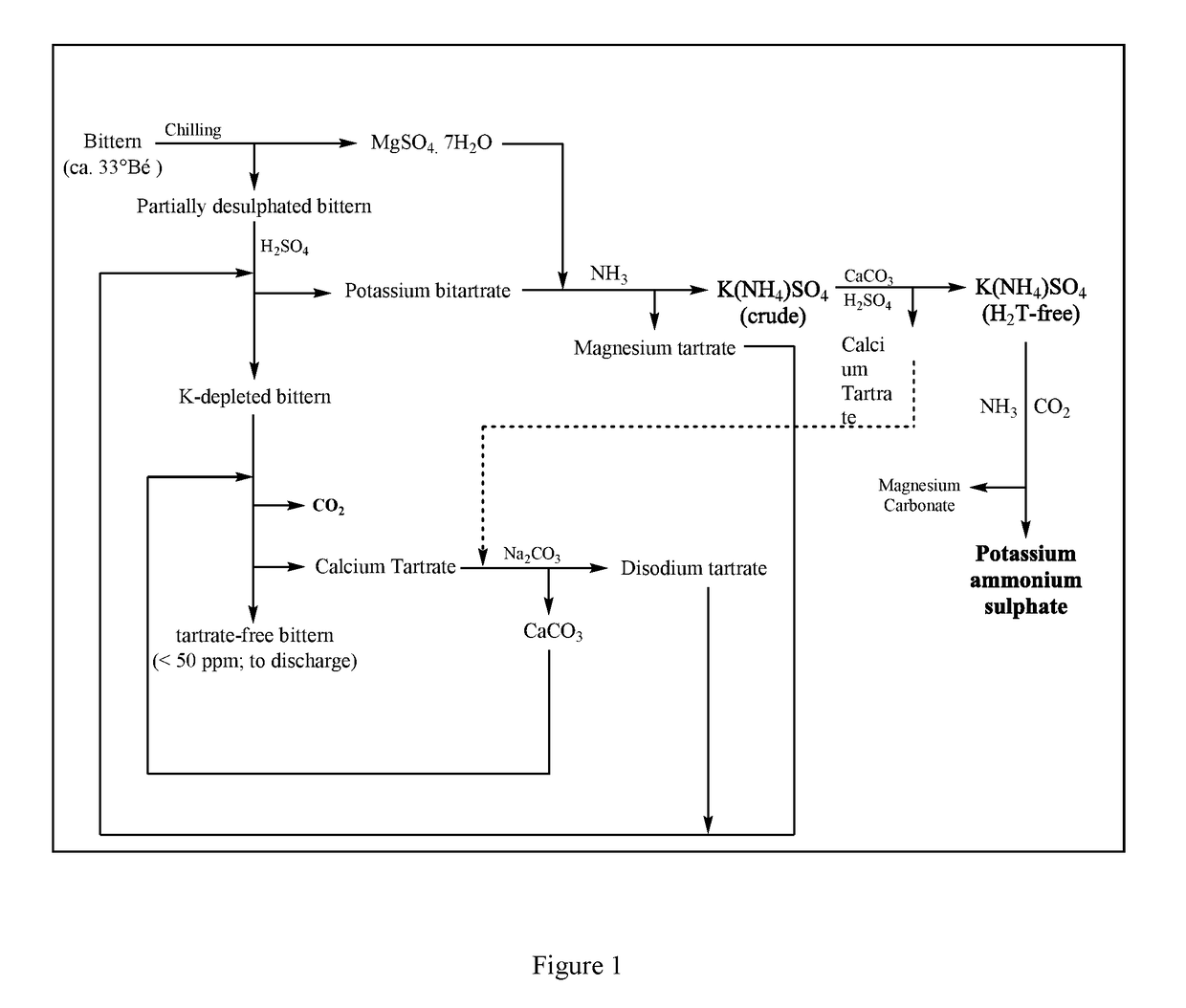A process of production of potassium ammonium sulfate compound fertilizer in cost-effective manner directly from concentrated sea bittern
- Summary
- Abstract
- Description
- Claims
- Application Information
AI Technical Summary
Benefits of technology
Problems solved by technology
Method used
Image
Examples
example 1
[0055]144.1 gm Epsom salt [Mg2+: 10.52%, Na+: 0.101% (w / w)], obtained upon chilling of sea bittern [specific gravity: 1.288, K+: 2.47%, Na+: 2.60%, Mg2+: 7.50%, SO42−: 9.00%, Cl−: 20.38% (w / v)] at 5±1° C., was dissolved in 600 mL water under stirring. 100 gm potassium bitartrate [K+: 22.00%, H2T: 75.01% (w / w)] and 37 mL liquor ammonia (23% w / v) were added into the solution sequentially. Stirring was continued for 12 hrs, maintaining the temperature at 28±3° C. Final pH of the reaction mixture was 7.2. Upon filtration of the resultant slurry, 600 mL filtrate [K+: 3.01%, NH4+: 1.03%, SO42−: 10.56%, Mg2+: 0.61%, H2T: 1.66% (w / v)] was obtained. The wet crystalline residue was subsequently washed with 150 mL water and air-dried to obtain 107 gm magnesium tartrate [Mg2+: 10.9%, K+: 0.1%, H2T: 54.67% (w / w)].
[0056]Example 1 teaches us the method for production of K(NH4)SO4 solution by reacting Epsom salt with potassium bitartrate and ammonium hydroxide.
example 2
[0057]300 mL concentrated sea bittern [specific gravity: 1.287, K+: 2.22%, Na+: 2.58%, Mg2+: 7.94%, SO42−: 8.31%, Cl−: 21.21% (w / v)] was mixed 60 mL water, 3.45 gm magnesium oxide and 25.67 gm DL-tartaric acid (H2T) under stirring. Stirring was continued for 24 hrs, maintaining the temperature at 22±3° C. Final pH of the reaction mixture was 0.98. Upon filtration of the resultant slurry, 342 mL filtrate [K+: 0.58%, H2T: 2.05% (w / v)] was obtained. The wet crystalline residue was subsequently washed with small aliquot of water and air-dried to obtain 22.33 gm potassium bitartrate [K: 19.04%, H2T: 76.05% (w / w)]. Potassium bitartrate yield was 63.71% with respect to K+ content in the concentrated sea bittern.
example 3
[0058]300 mL partially desulphated bittern, obtained after recovery of Epsom salt, [specific gravity: 1.26, K+: 2.16%, Na+: 2.36%, Mg2+: 6.58%, SO42−: 5.30%, Cl−: 20.28% (w / v)] was mixed 30 mL water, 3.35 gm magnesium oxide and 24.91 gm H2T under stirring. Stirring was continued for 24 hrs, maintaining the temperature at 22±3° C. Final pH of the reaction mixture was 0.99. Upon filtration of the resultant slurry, 310 mL filtrate [K+: 0.43%, H2T: 1.76% (w / v)] was obtained. The wet crystalline residue was subsequently washed with small aliquot of water and air-dried to obtain 27.33 gm potassium bitartrate [K: 17.91%, H2T: 66.98% (w / w)]. Potassium bitartrate yield was 75.57% with respect to K+ content in the partially desulphated sea bittern.
[0059]Examples 2 and 3 teach us that partial desulphatation of concentrated sea bittern improves potassium bitartrate yield.
PUM
 Login to View More
Login to View More Abstract
Description
Claims
Application Information
 Login to View More
Login to View More - R&D
- Intellectual Property
- Life Sciences
- Materials
- Tech Scout
- Unparalleled Data Quality
- Higher Quality Content
- 60% Fewer Hallucinations
Browse by: Latest US Patents, China's latest patents, Technical Efficacy Thesaurus, Application Domain, Technology Topic, Popular Technical Reports.
© 2025 PatSnap. All rights reserved.Legal|Privacy policy|Modern Slavery Act Transparency Statement|Sitemap|About US| Contact US: help@patsnap.com

